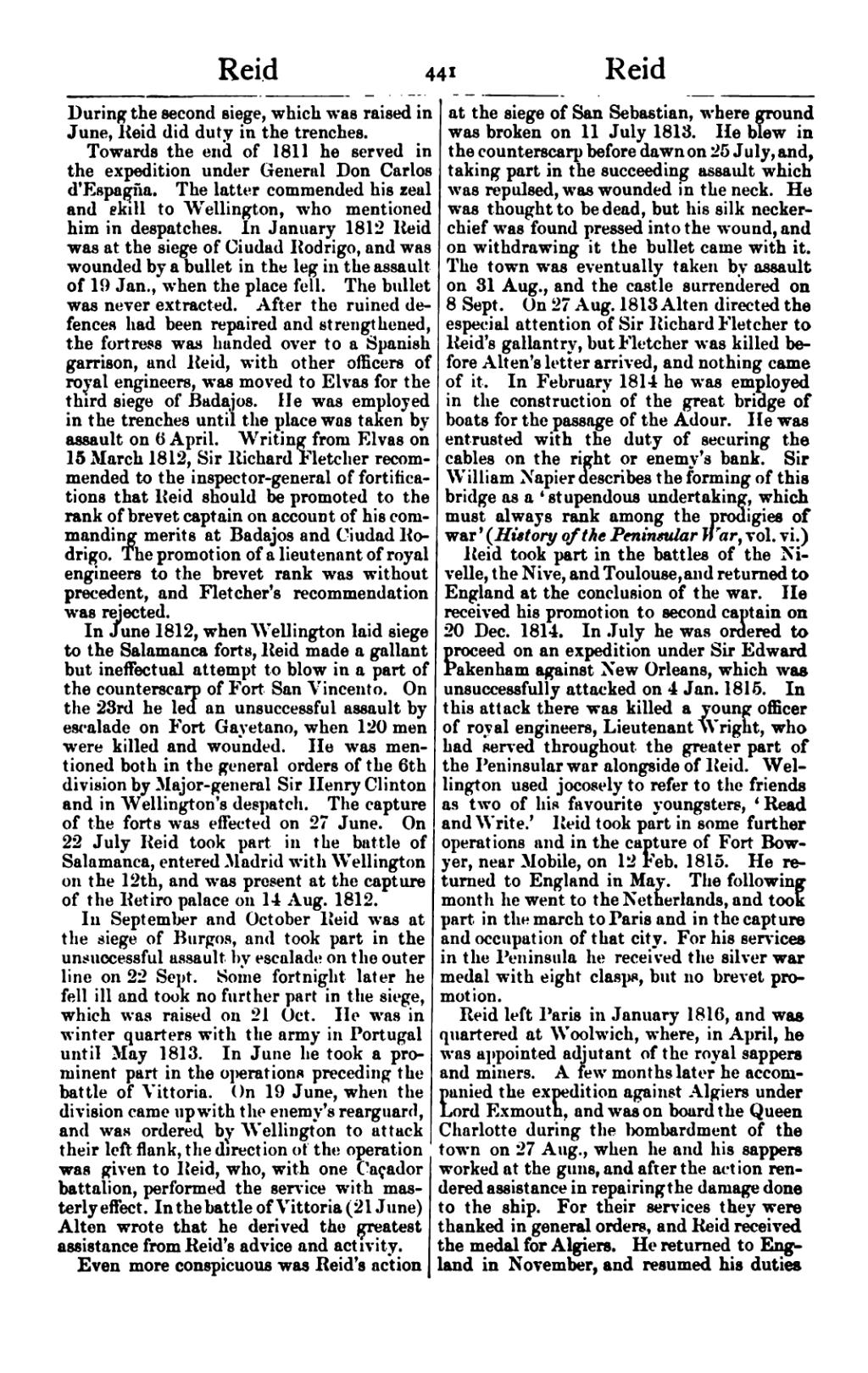During the second siege, which was raised in June, Reid did duty in the trenches.
Towards the end of 1811 he served in the expedition under General Don Carlos d'Espagña. The latter commended his zeal and skill to Wellington, who mentioned him in despatches. In January 1812 Reid was at the siege of Ciudad Rodrigo, and was wounded by a bullet in the leg in the assault of 19 Jan., when the place fell. The bullet was never extracted. After the ruined defences had been repaired and strengthened, the fortress was handed over to a Spanish garrison, and Reid, with other officers of royal engineers, was moved to Elvas for the third siege of Badajos. He was employed in the trenches until the place was taken by assault on 6 April. Writing from Elvas on 15 March 1812, Sir Richard Fletcher recommended to the inspector-general of fortifications that Reid should be promoted to the rank of brevet captain on account of his commanding merits at Badajos and Ciudad Rodrigo. The promotion of a lieutenant of royal engineers to the brevet rank was without precedent, and Fletcher's recommendation was rejected.
In June 1812, when Wellington laid siege to the Salamanca forts, Reid made a gallant but ineffectual attempt to blow in a part of the counterscarp of Fort San Vincento. On the 23rd he led an unsuccessful assault by escalade on Fort Gayetano, when 120 men were killed and wounded. He was mentioned both in the general orders of the 6th division by Major-general Sir Henry Clinton and in Wellington's despatch. The capture of the forts was effected on 27 June. On 22 July Reid took part in the battle of Salamanca, entered Madrid with Wellington on the 12th, and was present at the capture of the Retiro palace on 14 Aug. 1812.
In September and October Reid was at the siege of Burgos, and took part in the unsuccessful assault by escalade on the outer line on 22 Sept. Some fortnight later he fell ill and took no further part in the siege, which was raised on 21 Oct. He was in winter quarters with the army in Portugal until May 1813. In June he took a prominent part in the operations preceding the battle of Vittoria. On 19 June, when the division came up with the enemy's rearguard, and was ordered by Wellington to attack their left flank, the direction of the operation was given to Reid, who, with one Caçador battalion, performed the service with masterly effect. In the battle of Vittoria (21 June) Alten wrote that he derived the greatest assistance from Reid's advice and activity.
Even more conspicuous was Reid's action at the siege of San Sebastian, where ground was broken on 11 July 1813. He blew in the counterscarp before dawn on 25 July, and, taking part in the succeeding assault which was repulsed, was wounded in the neck. He was thought to be dead, but his silk neckerchief was found pressed into the wound, and on withdrawing it the bullet came with it. The town was eventually taken by assault on 31 Aug., and the castle surrendered on 8 Sept. On 27 Aug. 1813 Alten directed the especial attention of Sir Richard Fletcher to Reid's gallantry, but Fletcher was killed before Alten's letter arrived, and nothing came of it. In February 1814 he was employed in the construction of the great bridge of boats for the passage of the Adour. He was entrusted with the duty of securing the cables on the right or enemy's bank. Sir William Napier describes the forming of this bridge as a ‘stupendous undertaking, which must always rank among the prodigies of war’ (History of the Peninsular War, vol. vi.).
Reid took part in the battles of the Nivelle, the Nive, and Toulouse, and returned to England at the conclusion of the war. He received his promotion to second captain on 20 Dec. 1814. In July he was ordered to proceed on an expedition under Sir Edward Pakenham against New Orleans, which was unsuccessfully attacked on 4 Jan. 1815. In this attack there was killed a young officer of royal engineers, Lieutenant Wright, who had served throughout the greater part of the Peninsular war alongside of Reid. Wellington used jocosely to refer to the friends as two of his favourite youngsters, ‘Read and Write.’ Reid took part in some further operations and in the capture of Fort Bowyer, near Mobile, on 12 Feb. 1815. He returned to England in May. The following month he went to the Netherlands, and took part in the march to Paris and in the capture and occupation of that city. For his services in the Peninsula he received the silver war medal with eight clasps, but no brevet promotion.
Reid left Paris in January 1816, and was quartered at Woolwich, where, in April, he was appointed adjutant of the royal sappers and miners. A few months later he accompanied the expedition against Algiers under Lord Exmouth, and was on board the Queen Charlotte during the bombardment of the town on 27 Aug., when he and his sappers worked at the guns, and after the action rendered assistance in repairing the damage done to the ship. For their services they were thanked in general orders, and Reid received the medal for Algiers. He returned to England in November, and resumed his duties
